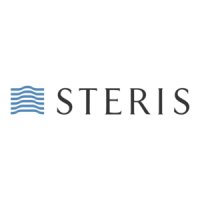
Do you have a question about the Steris InnoWave IW521020 Series and is the answer not in the manual?
| Brand | Steris |
|---|---|
| Model | InnoWave IW521020 Series |
| Category | Ultrasonic Jewelry Cleaner |
| Language | English |
Essential safety precautions for operating and servicing the equipment.
Required Personal Protective Equipment (PPE) for safe operation and maintenance.
Guidelines for safely transporting and storing the equipment according to package markings.
Recommendations for operator training content and record-keeping.
Defines the primary use of the InnoWave Ultra Sonic Irrigator for cleaning surgical instruments.
Details key features like heating, CPE, touch-screen, and data logging.
Explains how to identify the equipment model, serial number, and other details via labels.
Provides the name and address of the equipment manufacturer, Medisafe UK Ltd.
Lists applicable industry standards and regulations for the equipment.
States adherence to international decontamination standards and quality control.
Outlines compliance with RoHS directives on hazardous substances in electronics.
Guidance on proper disposal of the equipment and its materials as hazardous waste.
Step-by-step instructions for safely unpacking the ultrasonic irrigator.
Lists all components and accessories included in the equipment package.
Detailed instructions for correctly connecting the drain hose to the equipment.
Guide on installing and maintaining the recirculation filter in the tank drain.
Procedures for connecting power and performing the initial Power-On Self-Test (POST).
Description of the instrument basket, its flush ports, and loading recommendations.
Instructions for safely removing the instrument basket from the tank.
Guidance on properly loading general (non-cannulated) instruments into the basket.
Steps for connecting cannulated instruments to the basket flush ports using hoses.
Procedures for safely unloading instruments from the basket after the wash cycle.
Explains the touchscreen interface for operating the equipment and adjusting settings.
Provides a flow diagram outlining the steps for a complete wash cycle.
Steps for cleaning the equipment components before starting a new wash cycle.
Instructions for correctly placing the instrument basket into the tank and connecting it.
How to adjust wash cycle parameters like temperature, degas, and wash duration.
Guidance on filling the tank with water and monitoring temperature during filling.
Procedures and safety precautions for adding cleaning chemicals to the tank.
Conditions required before starting a wash cycle and how to initiate it.
Explains symbols and information shown on the display during a wash cycle.
Steps to take after a wash cycle has successfully completed, including unloading.
How to pause, resume, or abort an ongoing wash cycle.
Information on error messages and immediate actions required during a wash cycle.
Instructions for draining the tank fluids and preparing for the next cycle.
Critical safety precautions to be followed before and during maintenance procedures.
Routine daily tasks for cleaning and inspecting the equipment's lid and basket.
Recommended weekly tasks including daily checks, cable inspection, and decontamination.
Importance of setting and checking the equipment's time and date for record accuracy.
Detailed steps for performing a complete decontamination of the equipment using disinfectant.
Information on manufacturer-approved accessories and replacement parts.
Recommendations for periodic servicing by approved technicians and updating service records.
Overview of functions accessible via the supervisor menu, like PIN and language changes.
Steps to access and unlock the supervisor menu using a 6-digit PIN.
Procedures for changing the supervisor PIN, with warnings about forgetting it.
How to change the equipment's display and wash cycle log language.
Lists recommended brands of USB flash drives for use with the equipment.
Step-by-step guide to downloading wash cycle logs to a FAT32 formatted USB drive.
Table of error codes, their messages, and recommended remedies for diagnosing issues.
Common performance problems and their potential causes and solutions.
Technical specifications detailing the equipment's performance characteristics and operational parameters.
Details the electrical power requirements, voltage, and current for the equipment.
Specifications for the site drain connection, capacity, and effluent temperature.
Physical dimensions and weight of the equipment in both metric and US units.
Dimensions and liquid capacity of the equipment's internal tank.
Dimensions and maximum load capacity of the instrument basket.
Lists all available languages for the equipment's display and wash cycle logs.
Environmental conditions for operation, including altitude, temperature, and humidity.
Glossary of terms and definitions used throughout the operator manual.
Explanations of various symbols that may appear on the equipment and its labels.